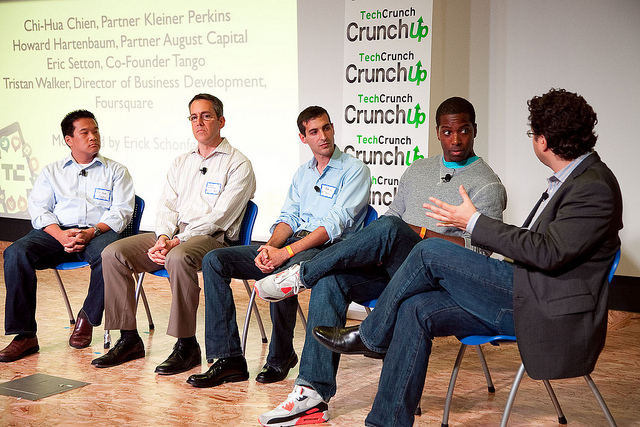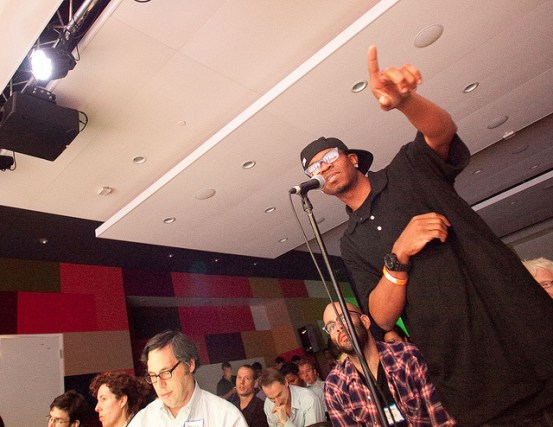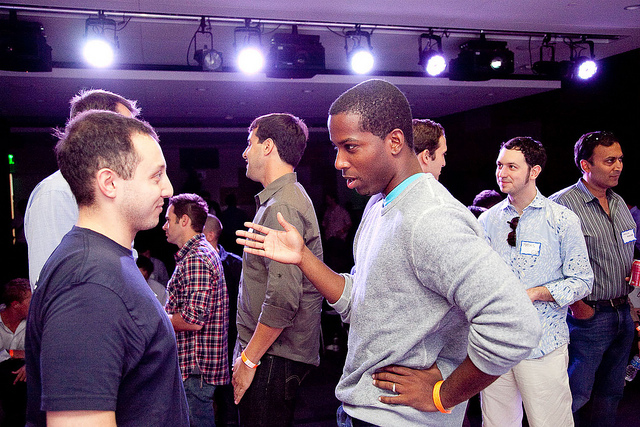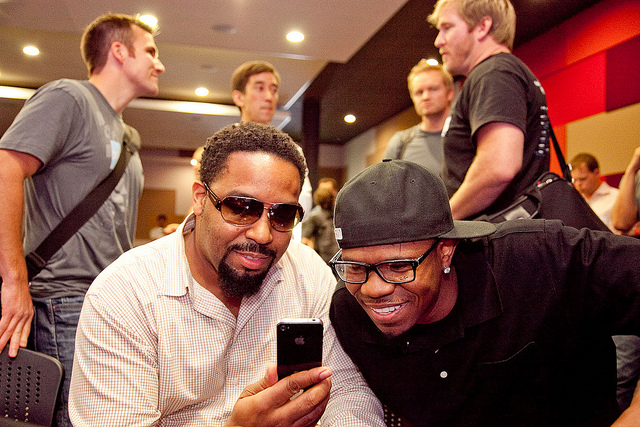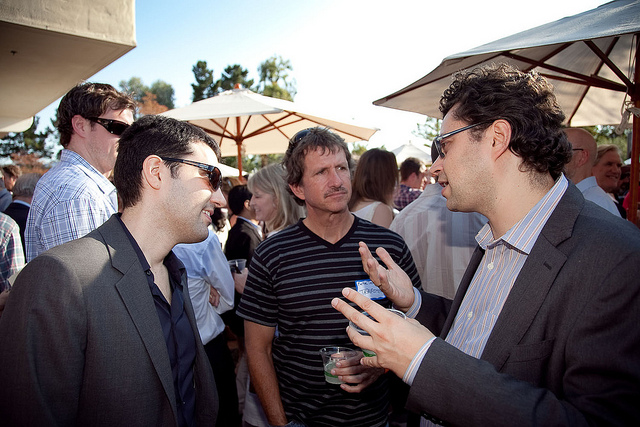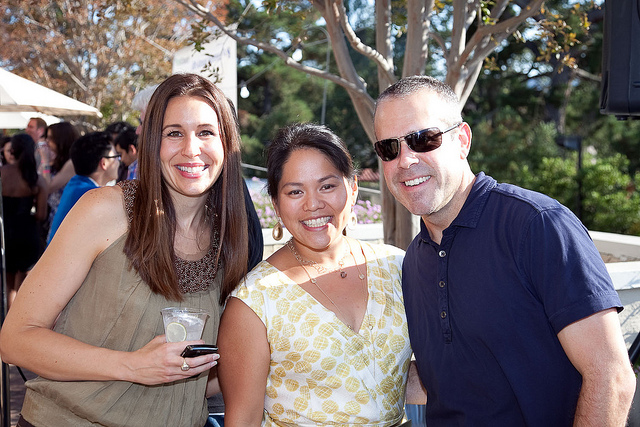The Latest from TechCrunch
The Latest from TechCrunch |  |
- (Founder Stories) Ben Lerer: Thrillist Will Do “$40 Million In Revenue This Year”
- Buying An Electric Car
- Healthcare Disruption: Providers Are Making Newspaper Industry Mistakes (Part III)
- A Billion Dollars Isn’t Cool. You Know What’s Cool? Basic Human Decency
- A Look Back On Our Mobile First CrunchUp And 6th Annual Summer Party At August Capital
- Don’t Be Fooled By Vanity Metrics
- Gillmor Gang 7.30.11 (TCTV)
- Technology + Politics = Facepalm
- Daily Crunch: Orbs
| (Founder Stories) Ben Lerer: Thrillist Will Do “$40 Million In Revenue This Year” Posted: 31 Jul 2011 09:20 AM PDT In this episode of Founder Stories, Chris Dixon sits down with Thrillist Co-founder and CEO, Ben Lerer (who is also a partner with his father Ken Lerer in Lerer Ventures). Targeted towards young men, Thrillist is a “platform for guys” that offers “both local and national content and commerce smooshed into one place” says Lerer. Inspired by Bob Pitman’s Daily Candy (Pitman is an early investor in Thrillist), Lerer founded Thrillist a couple years out of college. Before he figured out that he wanted to create a city guide for guys, he and his co-founder went through a lot of “get rich quick schemes” with the common thread that they knew nothing about any of them. The only thing they really knew about was “frivolous fun and buying stupid shit.” And thus Thrillist was born. A guide for guys with the voice of a national men’s magazine but a local focus. Today, the site has a loyal following of between 3 and 4 million male subscribers, who are highly attractive to brand advertisers but also very hard to reach. Lerer built the advertising and content business to a respectable 8-figure in annual revenues, but then he looked around at social commerce companies like Groupon and Gilt and thought he could grab a piece of that by setting up parallel commerce businesses and cross-selling to his demographic. So last year he bought JackThreads, a group buying site for men’s threads. In January, he layered on a deals business with Thrillist Rewards. Revenues shot through the roof. Lerer projects Thrillist will reach “about $40 million in revenue this year, almost tripling from last year.” He now employs 115 people, up from 45 last year. Not bad for a business based on frivolous shit. Watch previous episodes of Founder Stories here. |
| Posted: 31 Jul 2011 08:00 AM PDT This guest post is by venture capitalist David Cowan. David has recently purchased a Nissan Leaf after going car-less for two year. After 3.5 years, I've finally re-joined the community of car owners. Between February 2008 and last week, I was car-less. I borrowed and rented cars, took taxis and Zip cars, and occasionally biked. I also bummed a lot of rides (thank you very much – you know who you are). It had started when the warranty on my fancy German gas guzzler expired; I sold the thing, and never really found the time to shop around for a replacement – Who Has Time For This? I felt a lot more excited about the prospect of driving an electric sedan, which should be greener, potentially faster, simpler to operate, and cheaper to fuel. Most importantly, I'd never have to kill ten minutes stopping for gas – Who Has Time For This? So I put my name down on the lists for a Tesla Model S, Fisker Karma, Nissan Leaf and Chevy Volt, deciding to wait for one to be built. Three years later, I got calls from Fisker, Nissan and Chevy, and it was time to decide. After examining the options and driving the cars, it was a pretty easy decision to buy the Leaf for these eight reasons: 1. Compared to the others, the Leaf gets twice the range from a battery charge: 100 miles, or 85 miles with the AC cranking. (Plugging the car in and out adds about 15 seconds a day to your daily routine, or 5 minutes a month – about half the time we spend at gas pumps.) 2. With a pure electric motor (not a hybrid gasoline engine) the Leaf is nimbler, less fragile, and legal to drive in California's carpool lanes so I can bypass the Highway 101 traffic jams – WHTFT? 3. Driving in electric mode (without the help of a hybrid gasoline engine) is wonderfully quiet and smooth (no transmission). Even at 80 miles per hour the acceleration is immediate and impressive. 4. The Leaf steers as smoothly as a Lexus, and the small wheels turn on a dime. 5. Only the Leaf has open, comfortable seats with ample head room in front and leg room in back (a must if you have kids) 6. Only the Leaf carries 5 passengers (a must if you have THREE kids!) 7. The Leaf has the largest trunk, and the back seats fold down for more cargo space. 8. The Leaf costs 3/4 as much as the Volt, and 1/3 as much as the Karma. You get at least $7500 in tax credits, offset by the $2,000 expense of a home 220 volt charging station.  These reasons explain why the Nissan Leaf now the outsells the pack. I can think of only three good reasons why you might wish to buy one of the other cars: 1. The Leaf's pure electric motor is not a problem for two car families – on that rare day once a month when you drive more than 100 miles, you can always take the gas guzzler instead (Honda Odysseys are awesome). But without that fallback, one-car households will find the Volt more practical (albeit expensive and cramped).
2. If you love driving enormous, heavy sports cars that sit low to the ground and you've got $100k to burn (like these guys), then you might prefer the gorgeous design of the Karma. It has the look and feel of a luxury muscle car with a growling engine, bucket seats, and beautiful wood/leather interiors. (The Leaf is all plastic.) Having said that, the Karma performs like a sports car at lower speeds but on the highway I found it downright sluggish compared to the Leaf. The Karma handled highway acceleration nearly as well as the Leaf only when in Stealth Mode which means that the gasoline engine is off. (You may be as disappointed as I was to learn that people can still see you in Stealth Mode.)
All three cars come chock full of gizmos we all love (rear view camera, navigation, keyless entry, XM radio, Bluetooth, heated seats…) so there's no reason to stick with gasoline. The Leaf even comes with a cool iPhone app for remote operation of the charger and climate control. So I've been zipping around in my Leaf for a week now and absolutely loving it. Even after three years, it was worth the wait. |
| Healthcare Disruption: Providers Are Making Newspaper Industry Mistakes (Part III) Posted: 31 Jul 2011 07:00 AM PDT Editor's note: This guest post was written by Dave Chase, the CEO of Avado.com, a health technology company that was a TechCrunch Disrupt finalist. Previously he was a management consultant for Accenture's healthcare practice consulting to 25 hospitals and was the founder of Microsoft's Health business. You can follow him on Twitter @chasedave. Since the latter half of the 90's, the handwriting has been on the wall for newspaper companies that media's future was digital. Heck, the newspapers' own business sections reported on this trend. Despite this, the majority of the industry focused on traditional strategies such as taking on debt to acquire other newspapers or investing in new printing presses, leading to disastrous consequences. To be fair, there were some digital investments made, including hiring top-drawer talent. However, over time, the digital teams were marginalized and ultimately the talent that had the capability to transform these organizations left for opportunities where their hands weren't tied. In other words, the commitment wasn't deep enough to effect a true transformation. Now consider healthcare in the U.S.: There's a clear understanding that the industry must shift its focus towards outcomes from "do more, bill more" orientation. If ever there was an industry that should understand that it's more effective to address underlying conditions than treating the symptom, it should be healthcare. Or, as a famous early newspaper publisher stated, "an ounce of prevention is worth a pound of cure." Prevention-focused countries such as Denmark have dramatically lowered the need for hospitals. Once at 155 hospitals, they are at less than a third of that today. I find this easily-known fact is news to healthcare providers I speak with. Whether they don't know these facts or are ignoring them, the fact is there are incredibly large capital investment projects on the docket for many health systems. Since 62% of hospitals are mission-based, non-profit organizations, it's astonishing that they are more focused on capital projects than addressing the overall health of their communities. No one has made the case, for instance, that chronic conditions that consume 75% of the $2.6 trillion tab in the U.S. is best addressed by building more buildings. Some make the case that there's a growing healthcare real estate bubble while costs of chronic conditions continue to expand. In healthcare, it's as though we are building better firehouses and investing in more firefighting equipment while we do the equivalent of leaving oily rags around, letting kids play with fireworks on dry hillsides, and building structures with one exit. We may have the best "firefighting" tools and talent in the world but we'd be much better off if we prevented those "fires" from starting in the first place. Dr. Ted Epperly recently finished his term as the head of the American Academy of Family Physicians and runs the Family Medicine Residency of Idaho program, which includes 80 physicians serving over 20,000 patients. On a tour of his facility, he stopped to comment on the scene in the waiting room of their biggest clinic, something that’s typical of the many doctor’s office waiting rooms we've all experienced. He described the scene as a failure compared to the vision of what he's planning on implementing. In Epperly's vision, he describes a dashboard that pulls from the registry of all of their patients. Rather than reactively waiting for someone to present himself or herself in the clinic, he envisions a system that proactively is monitoring the array of conditions his patient population experiences. For example, it will ensure diabetics are having regular foot and eye exams and blood glucose levels are being consistently monitored. If someone hasn't scheduled an appointment already, it will proactively reach out to him or her rather than waiting for some health crisis. Epperly has been a leading proponent of a concept in healthcare called the Patient-Centered Medical Home (PCMH), akin to the philosophy that Denmark has adopted so successfully. In many respects, the PCMH is simply an updated version of the Marcus Welby model of medicine with more of a team-based model coupled with technology. While some may have noticed that there's several PCMH pilots that were included in the federal health reform law, there's a little-noticed facet of the law the CTO for the United States, Aneesh Chopra, points out in this video segment. That is, if the payment models that reward positive health outcomes over activity proves out in the eyes of the Actuary for Medicare and Medicaid program to be cost savings, there is carte blanche authority to expand these models broadly to entire Medicare population. This could rapidly expand the deployment of the PCMH concept and accelerate the need for the associated HealthTech. The video below explains this in more detail and explicitly speaks to the opportunity for startups.  Another healthcare provider plans to send home patients with an array of personal biometric devices. The output of these devices will be a more complete view of an individual's health. There's an explosion of personal biometric devices ranging from personal blood pressure monitors to some being built into clothing and widely deployed in places such as Denmark. For the cost of a small wing of one of these new Taj Mahal structures, healthcare providers could have a team of innovators working on scenarios such as those described above and many others. Those that avoid sticking to the old tried and true methods of differentiation that worked in the past will be light years ahead as the transformation of healthcare takes hold. If they don't, employers who are paying the bulk of healthcare costs are taking matters into their own hands and building their own onsite clinics. Whether the innovation comes from within or from non-obvious competition such as employers or pharma companies, there's a distinct advantage in having a blank slate where cost effective systems and models of delivering care can be delivered. For the providers, they'd be well advised to develop their own innovation teams unfettered by the current model so they can develop models that will ensure the provider's long-term survival. If you missed the first parts of the series, you can find them at the links below:
|
| A Billion Dollars Isn’t Cool. You Know What’s Cool? Basic Human Decency Posted: 30 Jul 2011 05:17 PM PDT ‘”Business!” cried the Ghost, wringing his hands again. “Mankind was my business. The common welfare was my business; charity, mercy, forbearance, and benevolence were all my business. The dealings of my trade were but a drop of water in the comprehensive ocean of my business!”‘ – A Christmas Carol, Charles Dickens I know, I know. I’m old. Worse than that, I’m nostalgic. In the past few months, I’ve written about my love for fountain pens, and traditional publishers, and paper books, and handwritten letters, and live theater, and downtown Las Vegas. Those who follow me on Twitter will have read about my enthusiasm for the New York Times Crossword, and hotel writing paper, and socializing with friends sans mobile phones. It’s cute to be the token Luddite at TechCrunch — but it’s also hugely disingenuous. I’m writing this stuff on Twitter, and on a hugely popular technology blog. You could cut the irony with a knife. The truth is, I love technology. It’s rare that I dismiss or disparage a new gadget, app or company without trying it out at least once; and I certainly believe that – on balance – the more technologically advanced we become as a society, the better the world becomes. And yet increasingly I wonder whether, for the sake of humanity, it might not be a bad thing if the earthquake comes and tips all of web 2.0 into the sea. I should possibly explain. The Internet — particularly “web 2.0″, with its communities and tagging and reuniting and friending and liking — was supposed to civilize us all. The idea was that by connecting the whole world through a variety of social networks and crowd-sourced standards of behavior (from reputation scores on eBay to Yelp reviews for dog walkers) – people would be driven to greater empathy for, and responsibility towards their fellow man. When Randi Zuckerberg sat on stage at DLD ’08 and told us the story of the Palestinian and Israeli children brought together through their joint membership of a Facebook group about soccer, we all shed a tear. Web 2.0 is working — it’s really working! In the early days, the entrepreneurs behind these services really seemed to believe the gospel they were preaching. Anyone who has met Craig Newmark will testify that he lives and breathes customer service — turning down acquisition offers and obsessing over how his eponymous List can help connect communities in ways that enrich society. When they invented Google, Larry Page and Sergey Brin really did dream about making the world’s data easier to access. Jimmy Wales, for all of his fixation with personal celebrity, really is passionate about a free and open encyclopedia, and has turned down a large amount of personal profit to realize that dream. At first, Web 2.0 seemed like a perfect two-way street. Brilliant entrepreneurs who genuinely wanted to change the world built services that we all wanted to use. They became rich, and our lives became better connected. We were all in it together. Fast forward just a handful of years, though, and something has gone very, very wrong with that particular social contract. We users have kept our side of the bargain — dutifully tagging our friends in artificially-aged photos, and checking in at bars, and writing reviews of restaurants. We’ve canceled our newspaper subscriptions, and instead spend our days clicking on slideshows of “celebrities who look like their cats” or obsessively tracking trending topics on Twitter. We’ve stopped buying books published by professional houses and instead reward authors who write, edit and distribute their own electronic works through self-publishing platforms. We’ve even handed the keys to our cars and our homes to strangers. On the face of it, the entrepreneurs have continued down the same track too: inventing ever more Disruptive companies to further improve the world, and in doing so enjoying multi-billion dollar valuations and all the trappings of fame and fortune. Even richer have grown the angels, super-angels and VCs who carefully nurture young entrepreneurs, molding them into the next breed of Mark Zuckerbergs and Sean Parkers, reminding their charges that “what’s cool” is a billion dollars — and that every new user acquired is another dollar added to their eventual high score. And yet. AND YET. You only have to look at a couple of mini-outrages that bubbled up in the past few days to realize just how misaligned the interests of some entrepreneurs have become with those of the human beings they rely on for their success. This time last week, the musical world mourned the death of Amy Winehouse. Almost immediately, the Huffington Post approved a post by unpaid contributor, Tricia Fox, entitled “Amy Winehouse’s Untimely Death Is a Wake Up Call for Small Business Owners“. We were all shocked, of course, by the callousness and cynicism of the headline — but we weren’t really surprised. We take it for granted now that the most popular online publications rely on search engine traffic for their survival. We know that, in many cases, “content” sites don’t employ editors to monitor what appears on their pages — and that those editors who are employed are encouraged to blindly approve any headline that name-checks a trending topic or two. Arianna Huffington talks a good talk about the democratization of journalism — but every so often we are reminded of the grimy truth: making money with online content is a question of attracting millions of eyeballs, whatever the moral cost. An even more grotesque example of this was this week’s Airbnb scandal — the so-called #ransackgate (ugh). Having been convinced by the company’s mantra of throwing open our doors to the world for monetary reward, a user by the name of “EJ” was shocked when a stranger comprehensively trashed her home. We’ll have to await the outcome of the police investigation to understand what really happened to EJ’s apartment, but what we know for sure is that Airbnb’s immediate, and subsequent, reaction was grotesque in its inhumanity. I’m not talking about the company’s initial apparent unwillingness to pay compensation — I’m talking about the behavior of the (unnamed) co-founder who wrote to EJ and asked her to remove her blog post about the incident, lest it affect the company’s ability to raise millions more dollars. From EJ’s blog…
Meanwhile, behind the scenes, we also know for sure that investors in the company leaned on publications like TechCrunch to stop reporting the story. Their ludicrous wail of protest: AIRBNB IS RUN BY NICE GUYS! IT’S NOT FAIR TO CALL THEM OUT WHEN THEY SCREW UP! The question of whether Airbnb is run by nice guys is irrelevant. For all I know CEO Brian Chesky is a modern day Mother Theresa who had to break off his important work curing kitten cancer to deal with this growing PR nightmare. What’s relevant — and all too obvious — is that good old Brian and his co-founders stand to make millions, if not billions, of dollars from the success of Airbnb. His investors stand to make even more. That kind of wealth can easily drive the most saintly of us to behave in inhuman ways — to become so remote from reality and humanity that users like EJ become (at best) PR problems to be solved and (at worst) irrelevant pieces of data; eyeballs or clicks or room nights to be monitized in the pursuit of an ever greater exit. And therein lies the real problem of web 2.0 — whether it takes the form of SEO-driven “news” or crowd-sourced accommodation. To make money — real money — at this game you have to attract millions, or tens of millions, of users. And when you’re dealing with those kinds of numbers, it’s literally impossible not to treat your users as pieces of data. It’s ironic, but depressingly unsurprising, that web 2.0 is using faux socialization and democratization to create a world where everyone is reduced to a number on a spreadsheet. Sarah Lacy has written about how many of the current breed of silicon valley wunderkinds have been conditioned to behave like the movie version of Mark Zuckerberg, eschewing humanity and decency for personal profit and glory. Nothing either she nor I can write will reverse the trend — there’s simply too much money and power at stake. But that doesn’t mean we shouldn’t loudly call bullshit on those who use words like “disruption” and “revolution” and “democratization” as cynical marketing buzzwords simply to line their own pockets, only to retreat behind the barricades when the going gets rough. And it doesn’t mean we shouldn’t mourn a not-too-distant past where technology entrepreneurs created things to make the world a better or more interesting place, not just because they wanted to make a billion dollars. And above all, it doesn’t mean we shouldn’t remind the current breed of entrepreneurs and investors that, in the final analysis, a billion dollars isn’t actually all that cool. What’s cool is keeping your soul, whatever the financial cost. |
| A Look Back On Our Mobile First CrunchUp And 6th Annual Summer Party At August Capital Posted: 30 Jul 2011 04:43 PM PDT We had a blast yesterday at our Mobile First CrunchUp and 6th Annual Summer Party at August Capital. At our CrunchUp, we had some amazing speakers and special guests. Even Chamillionaire managed to make a certain speaker sweat and started a debate on why Android doesn’t have a decent phone. Later in the day, the drinks were flowing at August Capital and even Ron Conway was spotted enjoying a margarita or two. Our summer party was a huge success and we want to thank everyone who came. We hope you had as much fun as we did. Follow @MJ_Isaac Mike Isaac Annnnd Chamillionaire takes the mic at #crunchup. Follow @Shirls Shirley Hornstein +10 to @tristanwalker for making sure his kicks match the orange #crunchup after-party bracelets perfectly. Inside information? Follow @harrymccracken Harry McCracken Kevin Systrom of Instagram says that an Android version is "absolutely" going to happen. #crunchup Follow @orenjacob Oren Jacob Here’s a deeper look at the CrunchUp:
A huge thank you to our sponsors who made this all possible. We couldn’t have done it without you. For more pictures, please check out our Flickr page. |
| Don’t Be Fooled By Vanity Metrics Posted: 30 Jul 2011 02:25 PM PDT Startups love to point to big growth numbers, and the press loves to publish them. We are as guilty as anyone else in this regard: one million downloads, 10 million registered users, 200 million tweets per day. These growth metrics can often be signs of traction (which is why we report them), but just as often they are not. It is important to distinguish between real metrics and what Lean Startup guru Eric Ries calls vanity metrics. Vanity metrics are things like registered users, downloads, and raw pageviews. They are easily manipulated, and do not necessarily correlate to the numbers that really matter: active users, engagement, the cost of getting new customers, and ultimately revenues and profits. The latter are more actionable metrics. As First Round Capital’s Josh Kopelman recently advised on Founder Office Hours, “The real data is retention and repeat usage.” Startups that focus on the real metrics can make their products better, attract more customers, and make them happier. It is important for startups to properly instrument the data they track so that they can get a handle on the true health of their business. If they track only the vanity metrics, they can get a false sense of success. Just because a startup can produce a chart that is up and to the right does not mean it has a great business. A mobile apps could have millions of downloads but only a few hundred thousand active users, or a freemium website might see exploding traffic growth but barely any conversions to paying users. Many startups, of course, track one set of numbers internally and selectively share another set of vanity numbers externally with the press. The worst is when startups try to pitch us with raw growth numbers (we are up 400%), but without any context (400% from what, 1,000 users or 100,000?). We always ask for more meaningful numbers, but those are not always forthcoming. The vanity metrics aren’t completely useless, just don’t be fooled by them. There are ways to back into real numbers from the vanity metrics. VC Fred Wilson blogged today about his 30/10/10 rule: 30 percent of downloads or registered users are active once a month, 10 percent are active once a day, and 10 percent of the daily users will be the maximum number of concurrent users. These are the patterns he is seeing in his portfolio companies and the startups pitching him. Startups would be better off, however, reporting real metrics from the start. Vanity metrics can catch up to them, especially if those numbers do not correspond to the real numbers. Facebook is a great example of a company that focuses on the right numbers. Even in its college-only days, it would always talk about daily active users (the users who come back every day) and how fast it took them to take over a particular campus. If more startups would measure and share the right metrics from the start, the rest of us would focus on them too. Photo credit: Skye Suicide |
| Posted: 30 Jul 2011 10:00 AM PDT The Gillmor Gang — Danny Sullivan, Robert Scoble, Kevin Marks, and Steve Gillmor — covered the gamut between Google+ and well, Google+. The new social platform continues to delight and confound the early adopters in record numbers. @scobleizer remains optimistic that the search giant will roll out filtering features to cut down on the noise of squids, kittens, and well, Scoble comment farms. @dannysullivan would prefer Google unleash the hounds of celebrity and brands, surprised as he and we are that the Plus team was caught flatfooted by the viral adoption of the field trial, or whatever Danny calls it. When we (Danny and I) started complaining about the lack of iPad support and Robert about the perils of high speed Scoble flow via the iPhone, @kevinmarks pointed out the ANdroid support sucked for tablets in general. All in all, much to look forward to and little or no competition from Facebook for Google to worry about. |
| Technology + Politics = Facepalm Posted: 30 Jul 2011 09:59 AM PDT Oh, how embarrassing. Earlier this week, Elizabeth May, the leader of Canada’s Green Party, took to her Twitter account and declared war on Wi-Fi. To think I very nearly voted for these clowns in our recent election. Lesson for my American friends: just because you find all the major parties unpalatable doesn’t mean that the fringe parties aren’t even worse. Meanwhile, can someone please get an environmental movement going that isn’t anti-science and anti-technology? Give her credit: she did manage, with rare ability, to hit not just one but all of the “idiot politician talking about science/technology” notes: 1. Moral panic: “It is very disturbing how quickly WiFi has moved into schools as it is children who are the most vulnerable.” 2. Deluded citation of long-disproven theories: “It is one prevailing theory re disappearance of pollinating insects.” 3. Misleading deception that comes this close to outright lying: “The World Health Org lists EMF as a possible human carcinogen.” Wait, what, the WHO called Wi-Fi possibly carcinogenic? Other so-called environmentalists seem to think so too. But no: it turns out that what they actually said (PDF) is: “The WHO/International Agency for Research on Cancer (IARC) has classified radiofrequency electromagnetic fields as possibly carcinogenic to humans (Group 2B), based on an increased risk for glioma, a malignant type of brain cancer1, associated with wireless phone use.” The WHO was worried about phones, folks. Not Wi-Fi. And that was in May. Recently, a major study of the subject concluded: Regular users of mobile phones were not statistically significantly more likely to have been diagnosed with brain tumors compared with nonusers … The absence of an exposure–response relationship either in terms of the amount of mobile phone use or by localization of the brain tumor argues against a causal association. But instead of backing away from her claims, Ms. May went ahead and doubled down on them. Hey, why let irrelevant things like facts and science get in the way of important stuff, like outrage and luddite paranoia? Follow @rezendi Jon Evans I hereby coin Evans's Law: Technology + Politics = Facepalm. See also: “internets“; “series of tubes“; and the recent trend of Twitter protests, such as #fuckyouwashington and #OpPayPal. To be fair, Jeff Jarvis, who spurred the former, has a thoughtful, nuanced, and to my mind accurate perspective on the subject. But at the same time, it strikes me as exactly the kind of meaningless and inconsequential thing that Malcolm Gladwell was talking about when he pooh-poohed the role of social media in political change. Now, I ultimately strongly disagree with Gladwell, but protests only matter if they grow into movements. Movements might use hashtags, but a hashtag is not a movement. Did any of the #fuckyouwashington or #OpPayPal tweeters start following each other? Was there any coordination? Or was it just a random and meaningless eruption, telling no one anything they didn’t know already? (“What? Many Americans are angry at Washington? Stop the presses!“) Anonymous claims that #OpPayPal resulted in the closing of 35,000 PayPal accounts. Even assuming that’s true, and that those were all active accounts (which seems unlikely) then their big protest has brought down less than 0.035 of 1% of PayPal’s total accounts. Big whoop. That equation above cuts both ways, I’m afraid: politicians tend to be idiots about technology, and most techies aren’t very bright about politics. Which is really too bad—because each is thoroughly disrupting and transforming the other, whether they like it or not. Image credit: Joe Mott, Flickr. |
| Posted: 30 Jul 2011 01:00 AM PDT Pixeet: Full Panorama Photos With Almost Any Phone |
| You are subscribed to email updates from TechCrunch To stop receiving these emails, you may unsubscribe now. | Email delivery powered by Google |
| Google Inc., 20 West Kinzie, Chicago IL USA 60610 | |


 3. Stephen Colbert will
3. Stephen Colbert will 